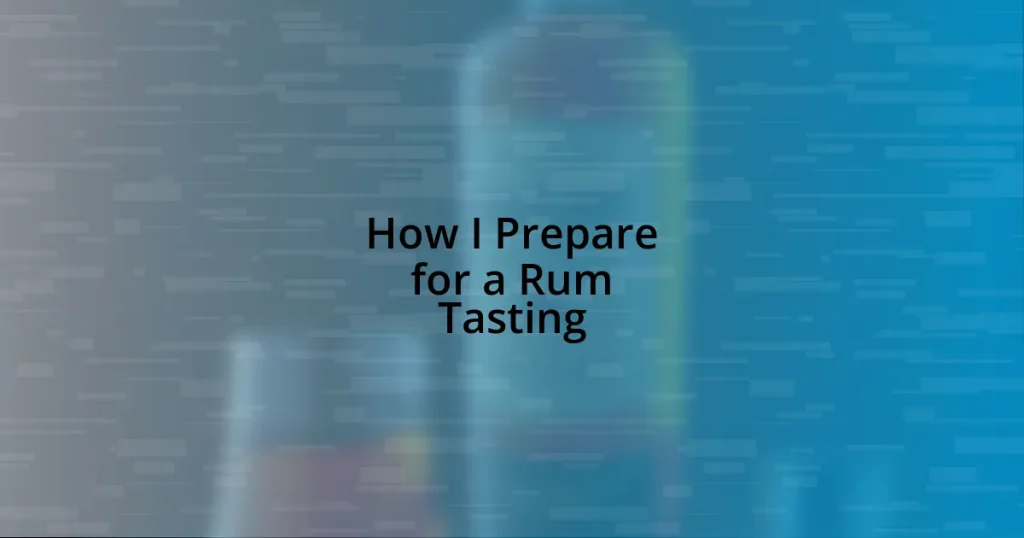Key takeaways:
- Start rum tasting by analyzing appearance, aroma, and flavor to appreciate the craftsmanship behind each spirit.
- Select a diverse lineup of rums from different regions and age profiles to enhance the tasting experience.
- Utilize proper tasting tools like tulip glasses and notebooks to deepen engagement with the rums being sampled.
- Create a comfortable and inviting tasting environment, considering factors such as lighting, temperature, and background music.

Understanding rum tasting basics
When it comes to rum tasting, understanding the fundamental characteristics of this spirit is essential. For me, the first step is really paying attention to the appearance; the colors can tell you a lot. I remember the first time I swirled a glass of dark rum and noticed the rich, amber hues, it felt like I was gazing into a treasure chest filled with history and craftsmanship.
Next, I always focus on the aroma, which is often the most captivating part of the experience. Have you ever inhaled deeply and found yourself transported to a tropical island, with notes of vanilla and caramel dancing around? It’s magical. The scent can reveal the aging process and the types of barrels used, and that connection to the makers’ choices makes each sip an exploration of their craft.
As I dive into tasting, I take small sips, allowing the rum to coat my palate. I can still recall the first time I savored a well-aged rum; the symphony of flavors was almost overwhelming. It’s not just a drink; it’s an experience that can evoke memories and feelings. How does a single sip manage to tell such a complex story? This is the beauty of rum tasting—each glass invites you to delve deeper into its origins and the passion behind its creation.

Choosing the right rums
Choosing the right rums can truly elevate your tasting experience. I like to create a diverse lineup that includes different styles, such as light, dark, and spiced rums. The first time I did this, I was surprised by how each rum brought its own unique flavor profile to the table, making it a delightful journey through different regions and production methods.
When selecting rums, I pay attention to the country of origin. Each region imparts its distinct characteristics—think of the fruity, floral notes from rums of the Caribbean versus the bold, earthy flavors found in South American varieties. I remember enjoying a rum from Jamaica that had a beautiful complexity; it whisked me away to a sun-soaked beach, one sip at a time.
In my experience, age plays a significant role as well. Older rums often have more depth and nuance, offering layers of flavor that younger rums might not possess. I once attended a tasting event featuring a 21-year-old rum that left a lasting impression on me. Its richness and smoothness were unlike anything I had tried before, reminding me how impactful age can be in the world of rum.
| Rum Type | Characteristics |
|---|---|
| Light Rum | Crisp and refreshing, often used in cocktails. |
| Dark Rum | Rich and complex, with hints of caramel and spices. |
| Spiced Rum | Infused with spices and flavors, offers a unique twist. |
| Aged Rum | Deep flavors developed over time, often smooth and rich. |

Gathering essential tasting tools
Gathering the right tasting tools is crucial for a truly immersive rum tasting experience. I find having the proper glassware enhances everything—from the aroma to the final sip. I vividly recall attending a tasting where the host emphasized the importance of using tulip-shaped glasses. When I held that glass, I could feel how it funneled the aromas, creating an intimate connection with the rum as I inhaled deeply in awe.
Here’s a checklist of essential tasting tools to have on hand:
- Tulip-shaped glasses: Ideal for concentrating aromas.
- Water drops: Helpful for adding a splash of water to release more flavors.
- Spit bowls: If you’re tasting multiple rums and want to keep your palate fresh.
- Notebook: Perfect for jotting down your thoughts and observations.
- Pen or pencil: For easy notetaking during the tasting.
Having these tools not only prepares you for the tasting but also adds a layer of enjoyment as you engage more deeply with each rum. The right setup transforms the experience into something special.

Preparing the tasting environment
Creating the perfect tasting environment is essential for enhancing the entire rum experience. I like to choose a comfortable space with good lighting, preferably something that feels inviting and relaxed. I once hosted a tasting on my patio during sunset; the warm glow and gentle breeze made every sip feel special, almost like each rum had its own story to share.
Temperature plays a big role, too. Rums shine best when they’re served at the right temperature—neither too cold nor too warm. I learned this the hard way during a tasting in a chilled room, where I struggled to detect the full bouquet of aromas. It really hit home for me that an optimal environment invites the rums to express themselves fully, allowing those complex flavors to unfold with each sip.
Finally, consider the background noise. I personally enjoy soft music that complements the tasting without being distracting. During a gathering last summer, I chose some smooth jazz that created a soothing atmosphere, making it easier to focus on the rums. What about you? Have you ever noticed how ambiance affects your enjoyment of what you’re tasting? Creating a thoughtful environment can truly elevate the entire experience, inviting everyone to appreciate the nuances of each rum together.

Developing a tasting format
Crafting a tasting format can genuinely elevate the entire experience. I’ve found that organizing a tasting into clear phases—such as sight, smell, and sip—creates a systematic approach that enhances understanding and appreciation. The first time I tried this, I was surprised by how breaking it down made me more aware of each rum’s unique characteristics, almost like unlocking a hidden layer of complexity.
I like to start with visual examination, inviting participants to look at the color and clarity of the rum. A memorable moment for me was when a friend remarked on the stunning amber hue of a particular rum, igniting a discussion about age and wood influence. It reminded me how much can be conveyed visually before the first sip even happens. Following that, focusing on aromas can be captivating; you might ask yourself, “What scents stand out?” In my experience, taking time to nose the rum entertains the senses and really sets the stage for the tasting.
As I guide others through these steps, I encourage them to share their perceptions. Everyone has a unique palate, and I’ve realized that the joy of rum tasting is partly in discovering these differences. It’s not just about personal preference; it’s an opportunity to learn from each other. Have you ever noticed how sharing thoughts on flavors can deepen your enjoyment of a tasting? Engaging in conversation around our impressions not only builds a sense of community but also enhances our overall experience.

Engaging with tasting notes
Engaging with tasting notes transforms an ordinary rum tasting into a rich exploration of flavors and aromas. I remember a recent session where we all scribbled our impressions on paper, and I was fascinated by how much detail emerged when everyone shared their notes afterward. It’s amazing how tastes can diverge; while I was captivated by hints of vanilla and oak, my friend detected spices and tropical fruits. This kind of dialogue not only broadens our understanding but also deepens our appreciation for each rum’s distinct profile.
As I read through the tasting notes, I often feel a mix of excitement and curiosity. What truly stands out for me is how these notes can spark memories or evoke emotions. For instance, one sip of a dark rum took me back to a beach vacation, where the warmth of the sun and the scent of the ocean mingled deliciously. Have you ever had a drink that transported you back in time? I find that connecting those feelings with the tasting attributes enhances the experience, making it more memorable and meaningful.
For me, engaging with tasting notes is also about the collaborative experience. I love encouraging everyone to express what they’re tasting—there’s something magical about hearing different interpretations. I recall tasting a rum together, and while my notes leaned towards caramel and warmth, a fellow taster captured an intriguing floral note. This exchange of insights not only revealed the complexity of the rum but bonded us in shared discovery. How often do we allow ourselves to step into someone else’s perspective? When we embrace these differences, we create a richer tapestry of flavor explorations.

Sharing experiences and insights
Sharing experiences often transforms the way we perceive rum. I recall a tasting where one participant shared her unexpected emotional connection to a spiced rum, reminding her of family gatherings where these flavors were central. That moment hit home for me; it was an eye-opener about how deeply personal memories can influence our palate. Have you ever sipped a drink that lingered in your mind long after? It’s a profound reminder of how flavors can weave into our life stories.
As we exchange insights during tastings, I find that each person’s perspective adds a new layer of richness. There was a time when a fellow taster excitedly described how a particular rum’s finish reminded him of crisp autumn evenings spent by the fire. That description changed how I viewed that rum forever. Isn’t it fascinating how a simple observation can unlock new flavors in your mind? I’ve come to appreciate that sharing isn’t just about notes; it’s about the stories we tell and the connections we forge.
In my experience, discussions about our observations can spark unexpected debates. Once, a spirited conversation erupted about the balance of sweetness versus spice in a particular rum. Hearing contrasting opinions ignited my curiosity—how could two people have wildly different tastes for the same spirit? It emphasizes a crucial aspect of tasting: it’s not just about agreeing on what you like but celebrating the diversity of our preferences. How do your taste experiences shape your understanding of rum? Embracing this curiosity becomes a delightful journey in itself.
















